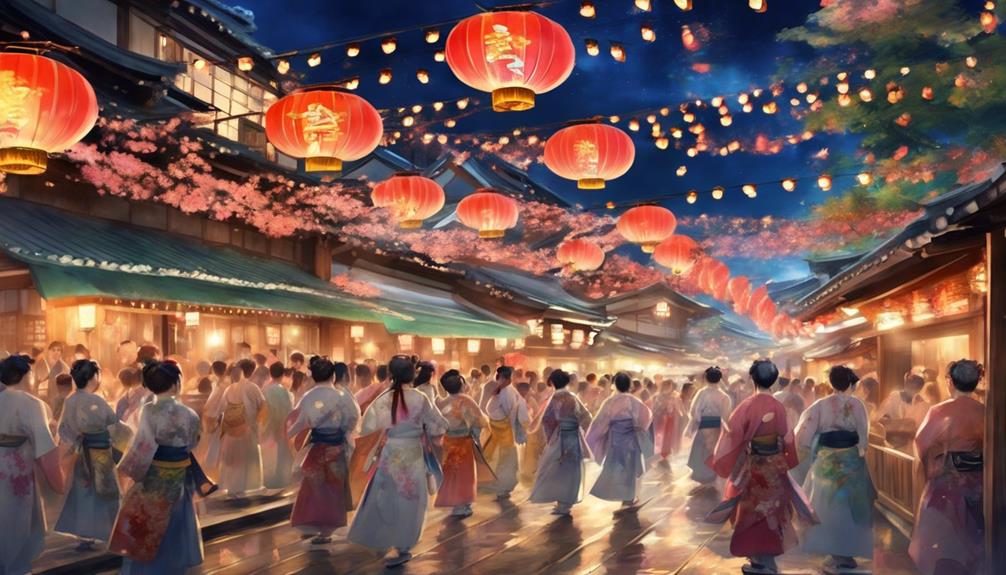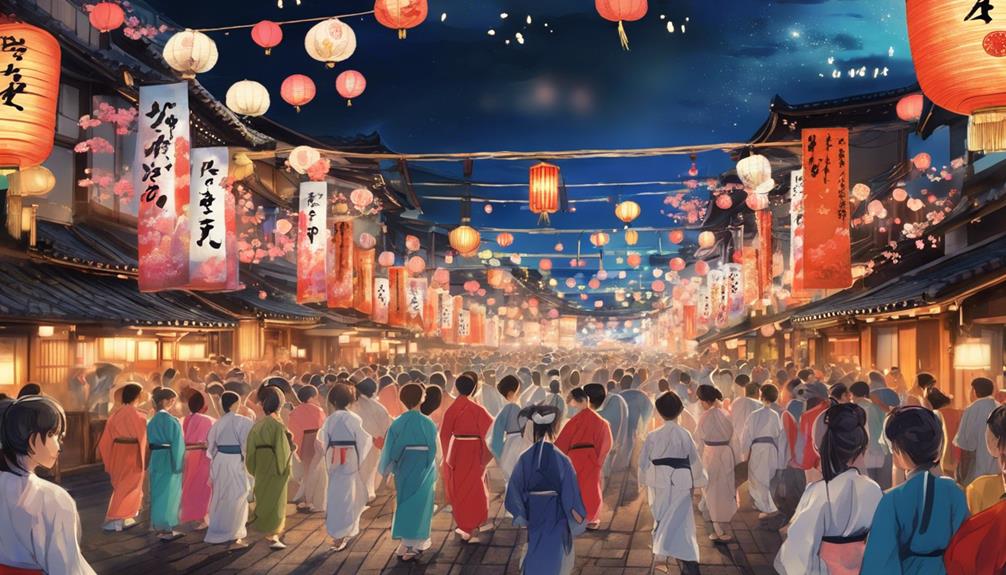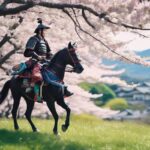Immerse yourself in the dynamic world of Tokushima Awa Odori in Japan. Experience the origins of this traditional dance festival dating back to the 16th century, now enchanting millions with its vibrant performances and cultural richness. Engage in the synchronized movements set to traditional music, featuring instruments like shamisen and taiko drums. Admire the intricate costumes, bold colors, and the use of accessories that enhance the performers' artistry. The festival offers engaging events, mesmerizing night parades, and showcases local cuisine like Tokushima Ramen. Pack light, clap along, and get ready to be swept away by this unique cultural extravaganza.
Key Takeaways
- Awa Odori originates from Tokushima, Japan, as a traditional harvest celebration.
- The festival showcases vibrant dance styles synchronized with traditional music.
- Tokushima's Awa Odori festival features nighttime parades with colorful lanterns.
- Traditional elements like taiko drums and shamisen are integral to Awa Odori performances.
- Tokushima offers diverse local cuisine and unique souvenirs for visitors to enjoy.
Origins of Awa Odori
Where did the vibrant and enchanting dance tradition of Awa Odori originate from?
Awa Odori, a mesmerizing Japanese dance form, has its roots in Tokushima Prefecture on the island of Shikoku. Dating back to the 16th century, this traditional dance holds immense cultural significance as it originally began as a celebration of a successful harvest. Over time, Awa Odori evolved into a renowned festival that attracts millions of spectators each year.
With its rich history, Awa Odori has also seen various regional variations across Japan. Different areas have put their unique spin on the dance, incorporating local customs and music to create modern interpretations while still staying true to the essence of the original Awa Odori dance.
These regional variations add depth and diversity to the tradition, showcasing the adaptability and creativity of the dancers and choreographers who continue to keep this ancient art form alive.
Dance Performances and Music
As you explore the vibrant world of Awa Odori, you'll encounter a mesmerizing array of dance styles that embody centuries of cultural expression.
The traditional music instruments, such as the shamisen and taiko drums, complement the intricate movements of the performers, creating a harmonious and rhythmic spectacle that captivates audiences.
Together, the dance performances and music blend seamlessly to narrate tales of tradition, history, and the spirit of the Awa region.
Dance Styles Featured
The dance styles showcased in Awa Odori performances are characterized by vibrant movements that are intricately synchronized with traditional Japanese music. This unique dance form holds immense cultural significance, deeply rooted in the history and traditions of Japan. Over the years, Awa Odori has evolved, incorporating modern influences while preserving its authentic essence, making it a dynamic representation of Japanese heritage.
The mesmerizing dance performances of Awa Odori have gained international appeal, attracting audiences from around the world. The energetic movements and colorful costumes have captivated spectators globally, leading to the participation of international groups in Awa Odori festivals. This cross-cultural exchange has enriched the dance form, showcasing its adaptability and universal charm.
Furthermore, Awa Odori has become a popular choice for dance competitions, where groups showcase their skills and creativity. These competitions not only celebrate the artistry of the performers but also provide a platform for innovation and collaboration within the dance community. The fusion of tradition and modernity in Awa Odori continues to enchant audiences and dancers alike, ensuring its enduring legacy in the world of dance.
Traditional Music Instruments
Traditional music instruments in Awa Odori dance performances play an essential role in creating the rhythmic backdrop that complements the dancers' movements. The instrument types used in Awa Odori are deeply rooted in Japanese culture, reflecting the historical evolution of traditional music in the region. These instruments hold immense cultural significance, as they are not only tools for creating music but also serve as links to the past, connecting present-day performances with the rich heritage of the festival.
| Instrument Types | Cultural Significance |
|---|---|
| Taiko Drums | Represents power and unity within the community |
| Shamisen | Symbolizes traditional Japanese musical heritage |
| Yokobue Flutes | Evokes a sense of nature and spirituality |
| Kane Bell | Marks significant moments and shifts in the dance |
| Shime-daiko Drum | Provides intricate rhythms and accents |
Musical techniques such as the rhythmic patterns produced by the taiko drums and the melodic accompaniment of the shamisen contribute to the dynamic and enthralling nature of Awa Odori performances. Understanding the historical context and cultural significance of these instruments enhances the audience's appreciation for the artistry and tradition embedded in each dance.
Traditional Costumes and Accessories
As you explore Awa Odori Japan, you'll encounter a enchanting array of traditional costumes and accessories that play an essential role in the festival's vibrancy. The intricate costume design elements, from the bold colors to the flowing fabrics, are a visual feast for spectators.
Additionally, the significance of accessories like fans and hats adds layers of cultural richness to the dancers' performances.
Costume Design Elements
Explore the vibrant world of Awa Odori Japan through the intricate and culturally rich Costume Design Elements, highlighting traditional attire and accessories.
The costumes worn during Awa Odori are a mesmerizing display of craftsmanship and symbolism. Embroidery techniques play an essential role in the design of these garments, with intricate patterns adorning the fabric. These patterns often depict traditional motifs such as waves, flowers, and geometric shapes, reflecting the rich cultural heritage of the region.
Color symbolism is also significant in Awa Odori costumes. Bright and bold colors like red, blue, and yellow are commonly used to evoke feelings of joy, energy, and celebration. The vivid hues not only catch the eye but also contribute to the festive atmosphere of the dance.
Additionally, the accessories worn with the costumes, such as bells and hats, enhance the overall look and add a sense of flair to the performers' movements. Every detail of the costume design in Awa Odori serves a purpose, blending tradition with creativity to create a visually stunning spectacle.
Significance of Accessories
Accessories in Awa Odori costumes play a significant role in enhancing the overall visual impact and cultural significance of the traditional attire. From the intricate fans held by the dancers to the symbolic sashes worn around the waist, each accessory adds depth to the performance. The cultural symbolism embedded in these accessories is profound, reflecting the values and heritage of the Tokushima region.
For example, the vibrant colors of the fans represent joy and celebration, harmonizing with the lively movements of the dancers. Moreover, accessories in Awa Odori costumes aren't just about tradition; they also reflect evolving fashion trends. While staying true to the roots of the dance, contemporary influences have led to subtle modifications in accessory designs, blending the old with the new.
This fusion of tradition and modernity showcases the adaptability of Awa Odori as a living art form, continuously resonating with audiences both locally and globally. As the dance evolves, so do its accessories, ensuring that the cultural heritage remains vibrant and relevant in today's world.
Participation and Workshops
Participating in Awa Odori workshops provides participants with a special chance to fully engage in the lively traditions and energetic dance of Japan. These workshops offer a unique opportunity to deeply involve yourself in the rich cultural heritage and dynamic movements of the Awa Odori festival.
Here's why you should consider joining one:
- Dance Classes for All Levels: Whether you're a beginner or an experienced dancer, Awa Odori workshops cater to individuals of all skill levels. Experienced instructors guide participants through the intricate steps and gestures that characterize this traditional Japanese dance, ensuring that everyone can actively participate and learn.
- Cultural Immersion: Engaging in Awa Odori workshops goes beyond just learning the dance steps. It provides a comprehensive understanding of the history, significance, and cultural context surrounding this vibrant art form. Participants gain insights into the traditions and customs that have shaped Awa Odori into the celebrated festival it's today.
- Performance Opportunities: For those looking to showcase their newfound skills, Awa Odori workshops often culminate in performance opportunities. Participants have the chance to join in public displays or even take part in the grand procession during the festival, allowing them to experience the thrill of performing in front of an enthusiastic audience.
Festival Schedule and Highlights

Experience the invigorating atmosphere of the Awa Odori festival through its engaging schedule of events and thrilling highlights. The festival, known for its vibrant festival atmosphere and rich cultural experience, takes place in Tokushima, Japan. The event locations are spread throughout the city, with main stages set up in key areas for performances and festivities. One of the most anticipated parts of the festival is the nighttime parades, where dancers in traditional attire move gracefully to the beat of taiko drums and the sounds of traditional instruments. These parades, illuminated by colorful lanterns and accompanied by lively music, create a mesmerizing spectacle that captivates both locals and visitors alike.
Immerse yourself in the dynamic energy of the Awa Odori festival as you witness the intricate choreography and spirited performances that showcase the region's unique cultural heritage. The festival schedule is packed with activities that offer a glimpse into the traditions and customs of Japan, making it a must-visit event for those seeking an unforgettable cultural experience.
Local Cuisine and Souvenirs
Enjoy the diverse flavors of Tokushima's local cuisine and explore unique souvenirs that embody the essence of Awa Odori festival.
The culinary scene in Tokushima offers a delightful array of food specialties, ranging from delicious dishes like Tokushima Ramen, a local favorite known for its rich pork broth and chewy noodles, to delicate sweets such as Awa Manju, a steamed bun filled with sweet red bean paste. Don't miss the opportunity to sample popular snacks like Sudachi citrus-flavored senbei crackers, a perfect blend of tangy and salty flavors that make for a satisfying treat during your festival adventures.
When it comes to souvenirs, Tokushima boasts a vibrant array of local crafts that make for unique gifts to commemorate your Awa Odori experience. From intricately woven indigo-dyed textiles to handcrafted pottery inspired by traditional Awa ceramics, there's a treasure trove of options to choose from. Take home a piece of Tokushima's rich cultural heritage with these distinctive mementos that capture the spirit of the festival.
Travel Tips and Recommendations

Enhance your journey to Awa Odori with essential travel tips and insightful recommendations for exploring Tokushima's vibrant festival atmosphere.
When packing for the Awa Odori festival, remember to bring comfortable clothing and shoes, as you'll be walking and dancing along the streets. It's also a good idea to pack light and bring a small bag for any souvenirs you might pick up along the way.
In terms of cultural etiquette, remember to be respectful of the performers and locals. It's customary to clap along with the music and join in the dancing if you feel comfortable. Additionally, learning a few basic Japanese phrases can go a long way in enriching your experience.
For transportation options, consider using the local trains or buses to get around Tokushima. Taxis are also readily available but can be more expensive. Language tips include having a few key phrases written down or saved on your phone for easy reference.
Frequently Asked Questions
Are There Any Age Restrictions for Participating in the Awa Odori Dance?
For the awa odori dance, age restrictions vary based on the cultural context. Participation often emphasizes dance experience, community involvement, and preserving traditions. Youth are typically encouraged to take part, fostering a sense of belonging and cultural appreciation.
Can Visitors Join the Awa Odori Dance Procession Spontaneously?
Yes, when it comes to dance etiquette and cultural immersion, spontaneous participation in a dance procession fosters community bonding. It allows you to fully experience the tradition, connect with locals, and embrace the lively spirit.
Is There a Specific Dress Code for Spectators Attending the Festival?
When attending festivals, dress codes vary. Some events request traditional attire to honor customs. At Awa Odori, wearing casual clothes is common. Embrace cultural significance by dressing comfortably to engage fully in the lively festival atmosphere.
Are There Opportunities to Learn the Awa Odori Dance Steps?
You can engage yourself in the art of traditional dance through dance workshops. These cultural experiences offer opportunities to learn the intricate steps of Awa Odori, a fascinating performance art that showcases vibrant movements and rhythms.
What Are Some Unique Souvenirs to Buy at the Tokushima Awa Odori Festival?
When at a festival, explore unique souvenirs like traditional crafts and local delicacies. These items capture the essence of the event and make for memorable gifts that showcase the culture and spirit of the celebration.
Conclusion
Overall, experiencing the lively and colorful Awa Odori festival in Tokushima, Japan is a must for anyone looking to fully engage in traditional Japanese culture.
From the energetic dance performances and vibrant music to the beautiful costumes and accessories, this festival offers a unique and unforgettable experience.
Don't miss the chance to participate in the festivities, sample local cuisine, and bring home some special souvenirs to remember your time in Tokushima.



